
So it seems the Democratic nominee may finally be set. After what a most astute commentator has called “The LONG FLAT SEEMINGLY ENDLESS BATAAN DEATH MARCH to THE WHITE HOUSE,” the end is finally within sight. It seems that Obama has numerically emerged the victor.
Members of this blog have been very active in campaigning for Senator Obama. I am sure they are pleased.
However, within our community, I believe a false dichotomy has often been presented. Some have stated that while many young Sikhs have been far more engaged with the Obama campaign, older members of our community have fundraised for the Clinton campaign. I believe that this age-difference distinction has always been grossly exaggerated.
Using Occam’s razor, a simpler thesis may suffice. While Hillary Clinton was the favorite at the beginning of the campaign, as the winds changed others were slower to jump on Obama’s bandwagon. I am sure we will see many ‘older’ Sikhs fundraising for Obama as we get nearer to the fall.
In fact, here is one voice that defies such characterization. Here is one Punjabi poet’s dedication to Obama (yes Phulkari, you get subtitles too!).
The Sikh Coalition was informed of Kamal Nath’s visit to speak at Northwestern‘s Kellogg School of Management tomorrow. There is a petition circulating for those of us deeply concerned about a Human Rights violator being hosted by Northwestern University. To have your voice heard, please click here and fill out the petition.
Thanks Anandica — just to add what are his offenses:
Kamal Nath, a Congress official close to the Gandhi family, helped lead a mob towards Gurdwara Rakab Ganj during the Delhi 1984 anti-Sikh pograms. He was present as a number of Sikhs were torched alive and was outside as the crowd pelted the Gurdwara, attempted to burn it, and massacre those that sought refuge inside. He has denied all allegations and numerous tribunals, although failing to convict him (or ANYONE for that matter) have all had serious questions about his alibi. [Jodha]
Those in Punjab who don’t have access to hospitals and licensed doctors often seek cures from quacks posing as medicine men and the plethora of cure-all medication sold by hawkers at bus stops. In central California too, illegal immigrants turn to traditional healers.
Immigrants interviewed amid the vineyards of Madera and the cantaloupe fields of Mendota said they had faced numerous obstacles to pursuing conventional medical care. Above all, they said, was cost, but other factors included fear of deportation, long waits for treatment in medically underserved areas, and barriers of culture and language.
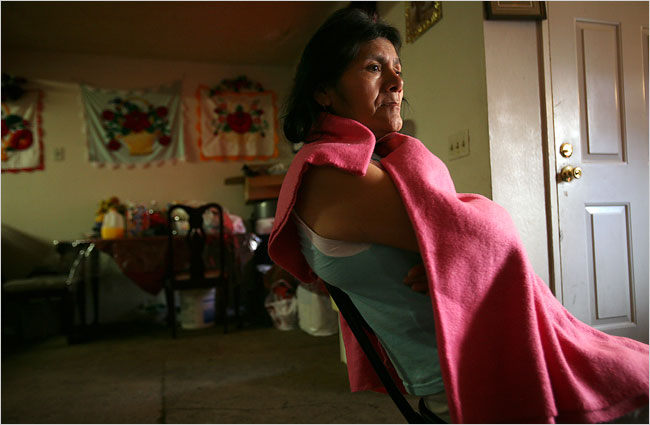 This article focuses on the Hispanic immigrant community, but the issue it raises applies to Punjabi Sikh legal and illegal immigrants as well. I would venture that some Punjabi immigrants (legal or illegal), because of the high cost of American health care, would prefer the care of a member of the community with questionable credentials to an emergency room of seemingly hostile nurses and doctors. We’ve mentioned many homeopathic medicines that many people find to be great for preventative and healing purposes. But there is a risk to traditional medicines too- that patients who may have serious illnesses will postpone diagnosis, aggravating an illness that could have been more easily addressed if diagnosed earlier.
This article focuses on the Hispanic immigrant community, but the issue it raises applies to Punjabi Sikh legal and illegal immigrants as well. I would venture that some Punjabi immigrants (legal or illegal), because of the high cost of American health care, would prefer the care of a member of the community with questionable credentials to an emergency room of seemingly hostile nurses and doctors. We’ve mentioned many homeopathic medicines that many people find to be great for preventative and healing purposes. But there is a risk to traditional medicines too- that patients who may have serious illnesses will postpone diagnosis, aggravating an illness that could have been more easily addressed if diagnosed earlier.
The situation may sound familiar to many Sikhs. Government forces practiced storming a religious center by creating a mock model. No, I am not talking about the Government of India in 1984 *[see bottom], but rather the American Government in 2008.
Last week, a number of US government agencies ran a drill to practice their emergency preparation. A newspaper reported:
For the purpose of Thursday night’s emergency exercise drill, the Continuing Recovery Center in Irving had become Irving Mosque, the home-base for a radical, heavily armed group with suspected terrorist ties.
There were explosions outside and inside the building. Illinois Law Enforcement Alarm System (ILEAS) special forces stormed the “mosque” from an armored car. [link]
Members of the Muslim community, I believe, rightfully protested the implications:
The use of a fake ‘mosque’ in this type of drill sends the wrong message to law enforcement officials who may now view mainstream institutions, such as Islamic houses of worship, as potential security threats,” said Ahmed Rehab, executive director of CAIR’s Chicago chapter (CAIR-Chicago). “Officials must be trained in dealing with hostage-taking and responding to chemical, biological or bomb attacks. We are only questioning the wisdom of linking the American Muslim community and its institutions to such incidents.” [link]
Those that join the teaching profession tend to be do-gooders. I recently came upon a Houston (Canada, not Texas!) teacher, Carroll Airey.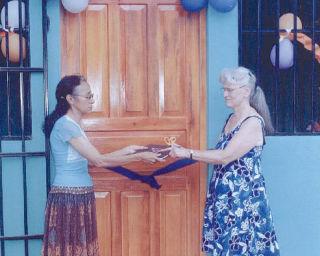
Carroll Airey is making a difference.
Airey, a retired Twain Sullivan teacher-librarian, has been fundraising for a town in Nicaragua — Santa Rosa del Penon — for almost 10 years.
Airey’s reach into Central American began in 1998 after Hurricane Mitch tore through the country. Airey set up the Children Helping Children club at Twain Sullivan and the group managed to raise $10,000 that helped out two communities: Santa Rosa del Penon and El Bosque. [link]
The article describes some of Carroll’s exceptional work. Through the sales of Fair Trade organic coffee, tea, and chocolate she has helped support a maternity clinic, nutrition program, garden project, and a sewing school. Recently, while in Nicaragua, she has begun efforts to house a library and a small computer center. Googling her on the internet, I found that she has also initiated a global arts exchange program between children in Houston (Canada, not Texas!) and Santa Rosa del Penon (Nicaragua).
A Non-Sikh friend of mine recently asked me about the naming conventions in the Sikh religion. She was wondering why “deep” and “jit” were so common at the end of Sikh names, and did this take away from a person’s individuality. (Like Joe Smith?) I thought it was an interesting point, but personally I don’t feel my name defines me. My uniqueness comes from my personality, the pursuit of my own path and growing through my experiences. Although I do feel I have grown into my name, and it does hold significance for who I am becoming as a human being. What is amazing about our names is the depth of their meanings, the interchangability of parts of the names to create a new meaning, and that they are epicene names. When I do tell Non-Sikhs what my name means, the response is always “Wow, that is so cool!”.
A new pattern emerging these days is the shortening of the name and/or being creative with the way it is spelt. It is inevitable changes will happen as we assimilate to the western world we live in, and with the generational changes that are happening. People used to put faith with the Guru Granth Sahib and the first letter that was chosen, at random, became the starting point for naming a new baby. Is this a tradition that is being utilized today?
We have such an immense choice of names, and I have yet to find a culture that holds deeper meanings for their names, however common they may be, than ours.
I pose this question to you all: What does your name mean to you?
Our phones have become an extension of our bodies. Walk around outside and you’ll see the dawn of the blue-tooth era with the masses walking and having conversations with everybody, but the people that are actually physically near them. Seeking to capitalize on the trend, phone companies seem to sell us everything but the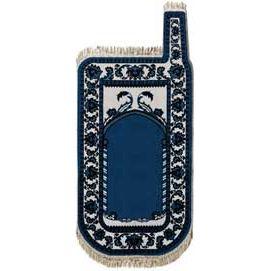 actual plan. You can buy wallpapers, ringtones, and other superfluous things to ‘pimp your phone.’
actual plan. You can buy wallpapers, ringtones, and other superfluous things to ‘pimp your phone.’
In the ongoing process of religious commoditization, many faith-based entrepreneurs are peddling faith-based phones. Mike Elgan, a writer for Computerworld, has recently asked, “What religion has the best mobile phone?”
Which of the world’s greatest religions, Christianity, Islam, Hinduism, Buddhism, Sikhism and Judaism (listed in order of size), has the world’s greatest mobile phone?
While researching this article, I was unable to find a single Christian, Hindu or Sikh mobile phone. I’m not saying they’re not out there somewhere, just that I’m “agnostic” on the point. I just don’t know.
We know the Britney Spears and Miley Rays of Hollywood tremendously influence the lives of our pre-teen and adolescent girls. The voices we keep hearing on television are those of white, multi-generational American, and suburban teens.

Their experiences are being boxed and represented as THE experience of adolescent girls in America. Rarely on television does the media interview pre-teen and teen girls of color from immigrant backgrounds living in urban/rural areas about their perceptions of life and the future – unless the story is on teen pathology from pregnancy to drugs and violence.
Therefore, I was pleased to see the trailer of a documentary, “Going on 13”, that is about pre-teen girls from minority, immigrant, and urban backgrounds discussing how they negotiate the whirlwind of changes and choices, from body image to relationships, just as girls in the suburbs.

The only distinction is how their social, economic, and cultural contexts add a different layer to the experience that is not a form of “mal-adaptation”, but another way of living. The film-makers’ goal was “… to show the reality of preteen girls and urban minorities, which isn’t often portrayed in the mainstream media” and “… wasn’t just focused on the pathology of urban youth”.
While we’ve heard a recurrent Canadian voice that claims that Sikhi is incompatible with being openly LGBTIQ, a new Sikh-specific support group has grown in Vancouver. There have certainly been South Asian-specific support organizations in the diaspora for the last decade or so (within the U.S., Trikone in SF, and SALGA on the east coast). However, these organizations have been challenged to create space for those at the intersections of regional and religious identity — i.e., between a Punjabi/South Asian ethnic identity and a Sikh religious identity. Similar organizations have recently sprouted up in the queer (South Asian) Muslim community, but this is the first formal Sikh support group I’ve heard about.
This made me reflect on other issues of integration and advocacy across communities. I think it’s vitally important to have community organizations, in part because they play a large role in creating sustainable institutions. However, I also resent that “mainstream” organizations sometimes use these institutions as an excuse for failing to provide comprehensive services for the true diversity within a larger, umbrella community. I also worry that it’s only possible to get this level of specificity in areas where there is a large enough community to achieve a critical mass.
What do you think, readers? Would a Sher in your area provide a necessary safe space? Would it be feasible?
Previous coverage: Towards a Queer ethos, A “Sensible” Religious Response to LGBTIQ Sikhs
While I had contemplated covering some serious news, scouring through Google News, an article caught my attention. Today happens to be the 33rd birthday of David Beckham. Not that I really care, but the article 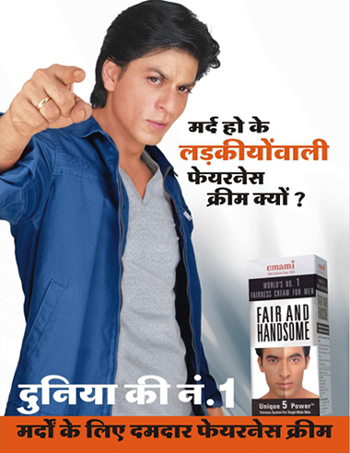 bemoans how David lost his star status over the past few years:
bemoans how David lost his star status over the past few years:
From 2003 to 2004, Google ranked his as the most popular sportsman in the world, by virtue of the number of times his name had been logged in. But in 2008, David Beckham’s popularity has been confined to reports of his luncheons with his wife, Victoria, and her famous girlfriends — Eva Langoria and Katie Holmes. [link]
The article theorizes that Beckham had gotten too large for life. I had my own theory….since Beckham had always been labeled as the “poster boy” for metrosexuals, maybe we finally got sick of him. Maybe, after a decade of this god-awful trend, we have returned to normalcy and are in the post-metrosexual age. Eager to test my hypothesis I devised the full-proof experiment — I would look up the word “metrosexual” in Google News.
As far as my hypothesis goes, I WAS WRONG!
Most people who lived through Partition are understandably hesitant to talk about it. A decade long Ford Foundation study says that one fourth of those interviewed about Partition so far have never even recounted their stories to their children. So I was pleased to find this diary type piece about Delhi in the aftermath of Partition. It’s personal.
When I was a little girl I was living in Sita Ram Bazaar in Gali Kulub Din which was at a twilight
zone between Turkman Gate (an all Muslim area) and the temple of Chaurasi Ganta, the 84 bells, an all Hindu area. Both the communities met midway and had lived together happily for many centuries till the partition occurred in 1947. We had moved there in 1948, when I was four months old; however, my memories of the place date back to the time when I was four and my younger brother Ravi was about to be born in the year 1952. Several Muslim properties, belonging to the families migrated to Pakistan, were lying vacant in our street, the Gali Qutub Din. However, a sizable Muslim population had also stayed back.
It also invokes visuals. 2 things caught my attention. First was the mention of abandoned homes:
Early last month, UNESCO ‘supposedly’ released a report that said Punjabi will become extinct in the next 50 years. Soon our one-man PR campaigners (we have many in our community) came to the forefront. In the lead was Kuldip Nayar, who said:
“I have gone through a report prepared by Unesco which says the Punjabi language will disappear from the world in 50 years. It shocked me. I am out to save Punjabi language and culture… Our roots, Punjabi language and culture, are decaying and none in Punjab is worried about it,” he said, adding, “I have been to Pakistan and people there also feel their new generation feels hesitant to converse in Punjabi.” [link]
Ranked in the top 20 most spoken languages in the world, it created quite a sensation to believe that within 50 years the Punjabi language would go extinct. However, some ACTUAL journalists that took the time to delve into the subject without jumping on the hysteria-bandwagon found that no UNESCO report ever existed. So I guess it begs the question, what was Kuldip Nayar reading when he said he ‘[went] through the report’? What was he reading that ‘shocked’ him?
So while Punjabi does not seem to be endangered for the time being, it is under severe threat due to Punjabi Sikhs’ own lackadaisical treatment of it, as well as it not being a language of commerce. The World Sikh News report has some fine suggestions for its preservations. One of our own langa(w)riters had their own take as well.
So as we get ready for the weekend, I celebrate my maboli as a universal language. Punjabi Maboli Zindabad! Chak De!
Guest blogged by Mewa Singh
This evening I had the opportunity to view a screening of a new documentary on the tragedy and heroism of the Sodhi Family. From the website of “A Dream in Doubt” comes the synopsis:
“A Dream in Doubt” is an immigrant story in a world in which patriotism has morphed into murder. When Rana Singh Sodhi’s brother is killed in America’s first post-9/11 revenge murder, he begins a journey to reclaim his American dream and fight the hate that continues to threaten his community. This intimate, hour-long documentary of one man’s odyssey from persecution in India to embracing America as his homeland proves that courage and hope have the power to overcome hate.
I was a little hesitant to post about this, especially considering the numerous discussions we’ve had on this blog related to the negative image of Sikhs in the media.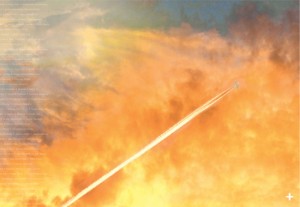 While a big fan of independent documentaries, I admittedly sighed when I came across an article about Air India 182, a film which was the opening feature at HotDocs, a film festival that was held in Toronto last weekend. My initial thought was that this was yet another way of perpetuating negative race relations in Canada.
While a big fan of independent documentaries, I admittedly sighed when I came across an article about Air India 182, a film which was the opening feature at HotDocs, a film festival that was held in Toronto last weekend. My initial thought was that this was yet another way of perpetuating negative race relations in Canada.
Air India 182, as it is simply titled, is a first-person account of the events leading up to the Air India tragedy and weaves together stories from those who are “directly involved,” including the families of those who died, investigators, and the “conspirators themselves.” Considering this, I didn’t expect to come across the director’s apt observations of how these events unfolded for the Punjabi community and what that meant for Sikhs in Canada,
Ultimately, Gunnarsson wanted to personalize the tragedy, to show the people involved, and give much more of a voice to the victims’ families, whom he believes didn’t get enough political recognition. “I felt at the time that people in Vancouver in the Punjabi community were being deprived of their rights as citizens of Canada. They did not have the same relationship to law enforcement or to political leadership as I did. It was being brokered through so-called community leaders, and the brokerage tended to happen at temples,” he says. [Link]
As I was exiting the parking lot of a major grocery store in a heavily concentrated Punjabi area the other day, I saw in my rear-view mirror a woman wearing a salwar-kaamez and holding a Bible with two Indian boys dressed in their “Sunday best” and carrying leather book bags, while they approached a man with a friendly smile. How surprised was I to see a Jehovah’s Witness woman wearing Punjabi clothing while she and these two boys proselytized in this Punjabi-concentrated area.
A few weeks prior, a friend of mine who lives in this same area, shared with me the story of how her family was confused to find a Punjabi couple at their front door delivering the message of God as Jehovah’s Witnesses. She told me that after hearing the door bell she ran to the door and peeped out the window and saw a man wearing a coat-pant and a woman wearing a salwar-kameez. Instantly, she knew they were Jehovah’s Witnesses because of the Bible they were holding and the other paraphernalia in their hands. My friend hollered to her dad that there was an Auntie and Uncle ringing the door-bell, but they looked like Jehovah’s Witnesses so she wasn’t going to answer the door. However, her dad responded rightfully so, “ekaan thaa teekh nahi laghdhaa … ladoo na dhaan ai hon” (that doesn’t look right they might be here to give ladoos).
A Siropa signifies an honor bestowed on a individual for their commitment to Sikhi and their long-term dedication. Lately, however, I am witnessing the increasing distribution of Siropay being “gifted” out based on monetary contribution, or the completion of attendance to an event. Has the true essence of our Siropa tradition disappeared?
Amitabh Bachchan caused controversy last December when he was given Prashad at the Harmandar Sahib, which included a Siropa. This controversy touched upon the ongoing actions of our Gurdwaras of presenting a Siropa for all the wrong reasons. There was value in this tradition when Guru Angad granted Guru Amar Das an honor every year. Guru Amar Das treated these gifts as sacred, and carried them all tied on his head. So when I witness a wedding couple receive a Siropa at Fremont Gurdwara, simply for being married in front of the Guru Granth Sahib, I am confused. The couple was clearly a couple who was openly not interested in Sikhi, so I was disappointed to see this happen at a Gurdwara which draws such a large Sikh community in the Bay Area. This was not the first wedding to happen at this Gurdwara, but it was the first I had witnessed with the giving of Siropay. I wondered, how many Siropay are being given out here each month? I meant to ask the Giani Ji at the Gurdwara why the couple received this honor, but never got the chance. Is this something that is happening at other Gurdwaras?
We are losing the value of this tradition if we continue to “gift” these articles of honor. What will be the difference between a person who has been practicing Sikhi with a true heart their whole life, and a person who plays a Sikh in a Bollywood movie? What will be the difference between a person who has awoken at Amrit Vela every morning to do their Paath for the past 40 years, and a person who attended the Gurdwara and donated a large sum of money?
Whose responsibility is it to decide who deserves a Siropa ? It seems to me that our Gurus left us with these traditions so we could follow them, then why are we making our own rules? As a Sangat should we be adding value to the decisions our Gurdwaras are making?
While Fortune Magazine used this picture in a recent advertisement for Dow Chemical Company, I first saw this image on the premiere issue of a new magazine I subscribe to. 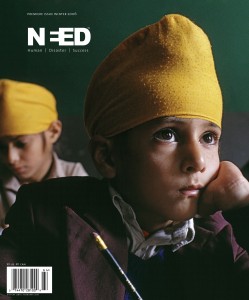 The image, by world-renowned photographer Steve McCurry, was chosen for the cover of the first issue of NEED magazine, an independent publication dedicated solely to global and domestic humanitarian issues.
The image, by world-renowned photographer Steve McCurry, was chosen for the cover of the first issue of NEED magazine, an independent publication dedicated solely to global and domestic humanitarian issues.
Steve McCurry is founder of ImagineAsia – an organization that helps children in rural Asian communities by addressing fundamental education and healthcare needs. The image, displaying Sikh children, was used to display (among other images) the pictorial state of education in Afghanistan. The education system in Afghanistan was virtually destroyed following successive wars and oppression by the Soviet Union and the Taliban. McCurry has been covering Afghanistan since before the Russian invasion in 1979. He has a unique and intimate knowledge of the country. He saw first-hand the turmoil of war and an entire generation of Afghans lose an opportunity to be educated. The result is a shattered country that ranks among the most illiterate in the world. [NEED Magazine]
Afghanistan’s children represent the country’s hopes for a better future, and education is the key to that future. The country’s new constitution makes education mandatory for children up to grade nine. This is a unique window of opportunity in Afghanistan’s history, a time when the need for education has been recognized and children are yearning to go to school. – Steve McCurry, Winter 2006 issue, NEED magazine.
You can order this issue (Winter 2006) of NEED magazine by viewing this website.
Recently, the Ontario Khalsa Darbar and the Punjabi Daily newspaper in Mississauga participated in Earth Hour to highlight the issue of climate change.
The Punjabi Daily newspaper from Mississauga has been urging its readers and Sikh
organizations to participate in EARTH HOUR. The Ontario Khalsa Darbar (Dixie Rd. Gurdwara Sahib-Sikh Place of Worship) has prepared for Earth Hour on March 29, a worldwide initiative launched by the WWF, the global conservation organization. It will be lights-off between 8 and 9 p.m. at the Gurdwara, where the hundreds gathered in the congregation will unite and use candles to pray for a cleaner and more peaceful world. “The Sikh Community has always taken a leadership role in protecting our environment. We are proud to participate in Earth Hour, which shows the Sikh communities commitment to protecting the environment, I encourage everyone to join in and turn off their lights for that one hour,” said Sukhminder Singh Hansra, of The Punjabi Daily, a Punjabi newspaper in Mississauga who urged the Sikh community join in using it’s editorials.
Earth Hour was a symbolic gesture to bring attention to the wastage of electricity and climate change. Though climate change is now almost universally accepted as a reality, its effects are often unclear. Some groups that had very little to do with contributing to its causes are already feeling the effects. Meet global warming’s first refugees (according to Sugata Hazra, the director of the School of Oceanography Studies at Kolkata’s Jadavpur University) in the Sundarbans:
This week the National Post launched a series about “Canada’s Biggest Mistakes.” Written by different columnists, yesterday’s big mistake was deficit spending. In today’s installment of the “top 5,” columnist Barbara Kay sets her sights on multiculturalism.
today’s installment of the “top 5,” columnist Barbara Kay sets her sights on multiculturalism.
I must admit I am not an avid reader of the National Post. In fact, I don’t think I had ever even heard of it prior to this column. However, Wikipedia informs me that it is a “voice for Canadian conservatives.” A brief perusal of Kay’s biggest hits, including as “Hug the Earth, kill the humans, ” “Barack Obama’s selective silence on his racist pastor, Jeremiah Wright,” and “The College Campus: Anti-Semitism’s last North American Refuge and Taking Back the Campus” helps me situate her on a political spectrum. In America, we call her David Horowitz and Bill O’Reilly. Well, enough of that, let us try to engage the substance of her argument.
Kay doesn’t mince her words on her stand:
Multiculturalism is Canada’s greatest mistake, but if it is any consolation, it is every western country’s greatest mistake. And now some of them are paying a terrible price.
PBS is currently running a fascinating documentary called Unnatural Causes which explores the racial and socioeconomic inequalities in health. Do we all have an equal chance for health? Is this inequality making us sicker? These are the questions that build the foundation for this seven-part documentary that looks at the root causes of health and illness and goes beyond popular conceptions linking health to medical care and explores evidence of more powerful determinants such as the social conditions in which we are born, live and work.
We spend more than twice the average rich country spends per person on medical care. Yet we have among the worst disease outcomes of any industrialized nation – and the greatest health inequities. At every step down the socio-economic ladder, African Americans, Native Americans and Pacific Islanders often fare worse than their white counterparts. The unequal distribution of social conditions – and their health consequences – are not natural or inevitable. They are the result of choices that we as a community, as states, and as a nation have made, and can make differently. Our international health status has fallen radically in the last few decades. In 1980, we ranked 14th in life expectancy; by 2007, we had fallen to 29th. [Link]
One issue that is particularly interesting is how racism adversely impacts an individual’s and ultimately an entire community’s health. Researchers are circling in on a way to explain the presence of worse health outcomes among minorities and suggest that the chronic stress of racism can be embedded in the body, taking a heavy toll on people of color. The researchers suggest that when you have a reaction to a situation in your life that makes you anxious or gets you stressed out, you not only have a psychological or emotional reaction but you also have a biological reaction. If that stress is chronic, over time it creates wear and tear on your body’s organs and systems and thus, causing illness. Another issue of interest is the fact that immigrants, who are often poorer, tend to be healthier than the average American. However, the longer they live here, the worse their relative health becomes, even as their economic status improves. Children of immigrants are particularly at risk for obesity, heart disease, and mental illness. The documentary explores what it is about new immigrant communities that shield people from poor health and how this protective shield erodes over time.
Both these issues are relevant to the Punjabi Sikh community. It’s important to look at the social conditions as mentioned in this documentary to help us understand the high rates of heart disease, obesity, diabetes, and mental illness that are impacting our community.
Unnatural Causes airs on PBS on Thursdays through April 17th.

 zone between Turkman Gate (an all Muslim area) and the temple of Chaurasi Ganta, the 84 bells, an all Hindu area. Both the communities met midway and had lived together happily for many centuries till the partition occurred in 1947. We had moved there in 1948, when I was four months old; however, my memories of the place date back to the time when I was four and my younger brother Ravi was about to be born in the year 1952. Several Muslim properties, belonging to the families migrated to Pakistan, were lying vacant in our street, the Gali Qutub Din. However, a sizable Muslim population had also stayed back.
zone between Turkman Gate (an all Muslim area) and the temple of Chaurasi Ganta, the 84 bells, an all Hindu area. Both the communities met midway and had lived together happily for many centuries till the partition occurred in 1947. We had moved there in 1948, when I was four months old; however, my memories of the place date back to the time when I was four and my younger brother Ravi was about to be born in the year 1952. Several Muslim properties, belonging to the families migrated to Pakistan, were lying vacant in our street, the Gali Qutub Din. However, a sizable Muslim population had also stayed back.

